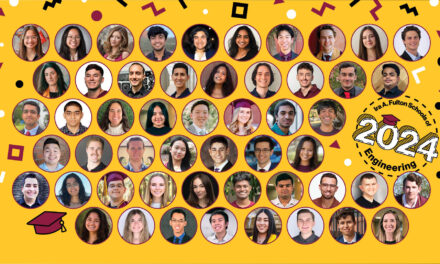
In memory of Géza Kmetty

The dramatic upheaval Géza Kmetty endured in his early years makes his life and career trajectories, professional achievements and contributions to engineering and higher education genuinely remarkable.
As a youngster, he left his homeland and family after the outbreak of the violent Hungarian Revolution of 1956, the revolt of many of Hungary’s citizens against the Communist government and its rule under the Union of Soviet Socialist Republics.
Suppression of the Hungarian rebels led to the deaths of thousands, while an estimated 200,000 fled as refugees. About 30,000 of them would be admitted into the United States, including Kmetty.
By 1965 Kmetty had earned a degree in civil engineering from Arizona State University, after moving to the state to join Esther, the woman he would marry and with whom he would raise a family of three children. Two of them are also ASU graduates.
Over the next 50-plus years, until his death on December 12, 2021, at 81, Kmetty would succeed in multifaceted technical and business endeavors and help to make advances in emerging areas of engineering.
He would also nurture new generations of engineers through teaching and mentoring, and through many generous donations to provide resources that have helped to make today’s Ira A. Fulton Schools of Engineering at ASU among the leading engineering schools in the country.
The gifts of his talent, time, mentoring and community leadership had tremendous impact on the future of what today is the School of Sustainable Engineering and the Built Environment, one of the seven Fulton Schools. As one of the five founding members of the Friends of Civil and Environmental Engineering, Kmetty helped create the organization that today advances the school through connections to industry and the community.
ASU Regents Professor Edward Kavazanjian, a former chair of the civil and environmental engineering program, recalls Kmetty’s desire to serve was exemplified when he joined the Friends of Civil and Environmental Engineering, which also focuses on supporting efforts to ensure and enhance the quality of education students are receiving.
“Typically, the $1,000 annual membership fee is paid for by the corporations or businesses members work for,” Kavazanjian says, “Géza was the first and still to this day the only member to pay the fee out of his own pocket.”
Kmetty’s passing “is a great loss to our school and the profession at large,” says Professor Ram Pendyala, director of the School of Sustainable Engineering and the Built Environment, home to the civil engineering program and the Del E. Webb School of Construction.
Over many years, Kmetty served as an adjunct instructor for civil engineering courses, and many times as guest lecturer in a variety of engineering classes.
“He cared deeply about our students and about the future of the workforce,” Pendyala says. “He devoted a lot of his time and energy to teaching our students about real-world engineering projects and to providing them the perspectives and the skills necessary to succeed in their careers.”
Pendyala adds that the Fulton Schools are fortunate that Kmetty’s “spirit of caring and giving has been passed on” to one of his sons, Chris Kmetty, who graduated from ASU with a civil engineering degree in 1997. The son is now “carrying on the amazing work of his father,” Pendyala says.
Chris Kmetty says his father had a wide range of engineering interests and pursuits to draw on for the lessons and knowledge he passed on to students, including work that helped pioneer some key aspects of modern engineering practices.

Géza Kmetty (at right) came to Arizona after meeting Esther, who lived in the Phoenix area and who would become his wife. Two of their three children would follow in the footsteps of their father as Arizona State University graduates. Photo provided by Chris Kmetty
Géza Kmetty’s expertise spanned multiple aspects of civil engineering design, transportation, urban infrastructure development, flood control, water systems and earthworks engineering.
He worked with government agencies and started his own small businesses — including Southwest Computing, one of the first consulting companies to have a computer, which he used for computer modeling for earthwork and hydrology projects in Arizona.
Kmetty went on to be an owner and partner in several consulting companies in Arizona, including NBS Lowry, McLaughlin Kmetty Engineers and finally Kmetty Consulting. After retirement from his engineering consulting work, he then worked for the Flood Control District of Maricopa County, helping establish its value engineering and scoping processes.
He served as president of the Arizona chapter of the American Society of Civil Engineers and on the board of the American Council of Engineering Consultants. He was also a recipient of the Arizona Transportation Legacy award.
Chris Kmetty says his father was also among the first wave of engineers to bring the application of computer modeling into the engineering field.
“He was at the forefront of engineering and design technologies and he broke new ground in using them for engineering projects,” he says. “That was what led to the start of the first company he owned.”
Kmetty was also an early member of the Society of American Value Engineers, helping drive another evolutionary step in the optimization of the economics of engineering projects.
The value engineering process involves formulas designed to provide optimal performance, quality, safety and reliability while achieving those goals at the lowest cost over the life cycle of engineering projects.
“I call him the godfather of value engineering in Arizona,” says Chris Kmetty. “He really was the one who pushed it here and convinced people in industry and government of its importance.”
His father also convinced the Fulton Schools to be one of the first university engineering programs to offer a graduate course in value engineering.
“Géza was very passionate about ASU and wanted value engineering in our curriculum,” says Professor G. Edward Gibson Jr., former director of the School of Sustainable Engineering and the Built Environment. “I met with him a number of times and he convinced us to add a graduate course to be taught to civil engineering and construction students.”
Géza and Chris Kmetty, along with and Faculty Associate Steve Kirk, team-taught the course for several years.
“It was very well received by our students. In the second year the course was taught, a student team from one class won a national competition focused on value engineering,” Gibson says, recalling that “Géza had a big smile on his face when he shared that bit of news with me. I always enjoyed interacting with him and he will be missed.”
For all of Kmetty’s technical mastery of his field, one longtime colleague and collaborator, Sandra Houston, a Fulton Schools professor emeritus of civil, environmental and sustainable engineering, thinks of him primarily as “maybe the most dedicated and loyal ASU supporter I’ve known.”
Kmetty for a time was a frequent guest lecturer in classes taught by Houston.
“He always wanted to work with students. He really believed civil engineering was one of the best professions in the world, and he promoted it fervently” she says. “He had an infectious spirit, and was just unfailingly enthusiastic about getting young people involved in the profession.”
Kmetty’s commitment, combined with his engineering accomplishments, innovations and industry leadership, also made him one of a select few outstanding graduates to be named to the School of Sustainable Engineering and the Built Environment’s Academy of Distinguished Alumni.



































